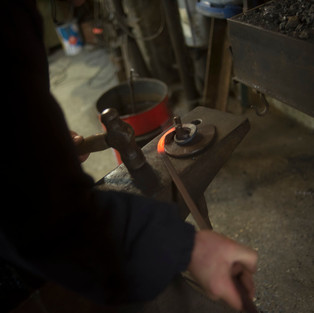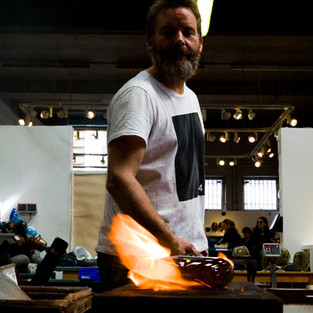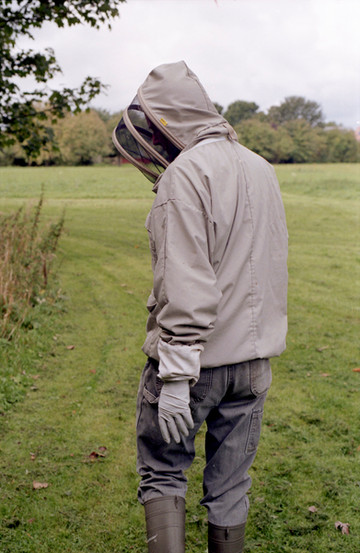Photography & words: Tom Warland

'The Wood Turner'
My work: The British Heritage Project is an ongoing personal record of the huge wealth of traditional crafts we have here in Britain, during a time where we come more and more to depend on the pre-made and the computer made. In the last decade, we have seen the collapse of the steel industry in the United Kingdom (2016), and now many other of our hard industries are hanging on by a thread such as: cricket ball makers, horse collar makers, and wheelwrights; and unfortunately, in the same years, some trades have disappeared from the country due to no one to inherit the skills required for them, traditional wooden ladders.
However, it is not all doom and gloom, we have also seen that some crafts a rise in popularity mainly through the hobbyist markets with a significant rise of micro-breweries crafting real ale. These breweries are not alone, across Great Britain there are artisan craftspeople learning ancient skills and trades and putting them into practice working on the knife edge that is between playing it safe, and total ruin;
“…all the works of men which have been most admired since the beginning of history have been made by the workmanship of risk, the last three of four generations only excepted. The techniques to which the workmanship of certainty can be economically applied are not nearly so diverse as those used by the workmanship of risk. It is certain that when the workmanship of certainty remakes our whole environment, as it is bound now to do, it will also change the visible quality of it.” (Pye, D. 1968). For them, the pride in the making is often the reward, and any financial gain is a bonus.
Some volunteer, learning the skills to repair Dry Stone Walls along canal paths so that they can repair the walls on their own farms and gardens, some will teach their children in time these same skills. Others set up their own businesses, spinning wool from the fleece to sell to local knitters. Some are linked with local traditions: regional foods such as Cheddar Cheese, Cornish Pasties, and the Melton Mowbray Pork Pie as the most famous of examples, but also the Cumberland sausage, and the Maid of Honour tarts that date back to the Tudors.
I suspect a big part of my interest in this work stems from a long family history of engineers. My Great Grandfather was an engineer at the East London Dry Plate Company – a company that later would be part of Ilford Photographic), my grandfathers were both Engineers, and my Dad is a draftsman. Growing up, the idea of replacing something without at least trying to fix it or reinvent its use first was not an option.
I have come to recognise that my approach to photography is like that of a Visual Anthropologist; in the sense that the camera not only teaches me (in the immortal words of Doretha Lange) how to see; but also, through the role as a photographer, I get to learn directly. I am fascinated by the reasons that people choose the trades that they have and will often spend more time watching and asking questions than I do with the camera in my hand. The photograph or film is my evidence of what I have learnt, and a memento for preservation.

While it is no secret that many of these topics are widely photographed, those who have made the biggest impact with their studies have focused on a smaller area – Patrick Sutherland Janine Wiedel, Chris Killip. For me, I have wanted to look across Britain covering all of England, Wales, and Scotland – and their accompanying islands (exclusion of northern Ireland from my study is practical due to my location in the Home Counties, but also a recognition that many of the crafts at home there, have a stronger relationship with Ireland as a whole.
Due to teaching commitments and of course the pandemic this last year I have not been able to cover much to the north, but I have met some wonderful craftsman across the southern part of our nation. Contemporary silversmiths who show not just similarities in their trade to other smiths, but also terminology I have seen in glass blowing studios and ceramics. Some have been kind enough to encourage me to try myself. I still have beside my bed a very rough attempt of making an arrowhead, a long way from the work that Will had shown me moments before my try.
The British Heritage Project is a series of photographic narratives and short films all produced using traditional photographic techniques, supported by both traditional British folk music collected and sourced from The Full English archives at Cecil Sharpe House, and original compositions recorded using traditional instruments.
Through each ‘chapter’ I examine the workings of individuals notable within their communities for the work they do, many of their trades and skills overlap, the skills of a farrier relate to those of the other smiths: Blacksmith, Whitesmith, Goldsmith and Silversmith, the terminology used by a Silversmith cross with those of the potter; the canal paths that are repaired by Dry Stone Wallers, were made for horses towing canal barges, these horses would need to be shod by a farrier, and need bridles and saddles made by a saddler, the boats they haul would be transporting material and wool to the mills to be spun, or precious metals to go to the forges of London and Birmingham, or to the dockyards around our coast where they board boats that share the seas with small independent fisherman struggling to keep a living in of fished seas.
We will see a rapid evolution to this subject matter as the country moves into a post-Brexit world? Will there be an increase in these works lives with more work being produced and higher profits? Or will the production of handmade items become even more constricted with the cost of materials going up due to separation from the free market?

Follow Tom here...
Twitter: @tombobwarland Instagram: @tombobwarland
Grafter:
Instagram: grafter_magazine
Twitter: @GrafterM
Facebook: Grafter Magazine
Email: graftermagazine@gmail.com
Get your Grafter merch now! 30 very exclusive tote bags- the first Grafter merchandise and once they are gone, they are gone! Make sure you support independent publications so click here to buy your shoplifting bag!
SUMBISSIONS!
We are always taking contributions - we want more political narratives, opinion-based articles, more art, events happening, music, poetry, personal essays, stories interviews.
Or maybe you want us to review or feature your work! If this sounds like you, send it to graftermagazine@gmail.com and don't forget to add what it is in the subject line!


























Comments